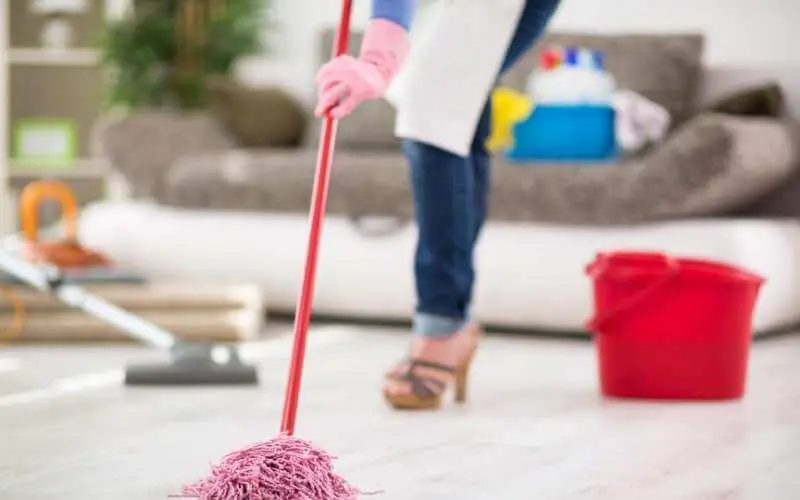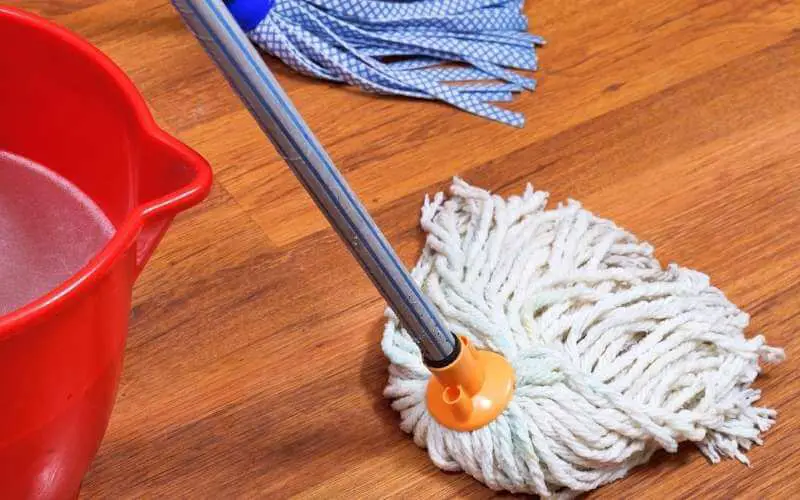Can you mop wood floors with bleach? Yes, you can mop wood floor with bleach but you need to make use of a proper bleach and neutralize it too. This answer might surprise you due to how infamous bleach tends to be on porous surfaces like wood floors.
Yes, you can mop wood floors with bleach. Though, it is advisable to bleach sparingly and with care. Carelessness might prove lethal as it might damage the wood floor or even cause physical damage to the body.
Let’s journey on to know how you can use bleach on the wood floors.
Types of Wood Bleach
Table of Contents
There are three types of wood bleach, this includes Chlorine bleach, Two-part bleach, and Oxalic acid. We would examine their uses and how they function.
Chlorine Bleach
This type of bleach is essential for getting rid of dyes and organic smears, like; tea, bloodstains, berry-based juice, and other stains. This mild bleach takes various methods before it proves useful.
Two-part Bleach
Two-part bleach is the best choice for altering wood color. In some cases, chlorine bleach doesn’t work with heavy stains, so you might need two-part bleach to help you with the process of removing heavy stains. They are the best choice for hard-to-fix areas. They are not to be used regularly.
Oxalic Acid
Oxalic acid’s primary function is to help remove moisture stains caused by iron content water. It also gets rid of iron-based black inks. Oxalic acid also gets rid of pet urine. Make use of the original oxalic acid for satisfactory results.
Read: How to remove bleach stain on laminate floor
How to Mop Wood Floors with Bleach
This is a step-by-step guide to ensure such an incident doesn’t happen.
1. Make Use of the Proper Bleach
To begin with, you should know the type of wood flooring bleach that best soothes your floor. There are different types of wood bleach you can use, depending on what is needed. Making the right choice would make the bleaching process free of hassles.
As stated earlier, the three types of wood bleach have varying functions, so it is best to make an adequate choice.
2. Prepare the Floor For Bleaching
Using a sander or a chemical stripping agent, prepare your wood floor for bleaching. This would help remove any form of resistance and make it easy to permeate the stain.
The best recommendation is sanding rather than chemical stripping agents. Chemical stripping agents are lethal and require a particular way of handling them.
Sanding also helps in stain removal, this would help reduce the amount of bleach needed.
3. Make Use of a Stiff Brush
Using a stiff brush, input the bleaching agent into the stain. Give it a duration of five to ten minutes. After the giving time, examine the stain, and apply more bleach if you find it necessary.
4. Neutralize the Bleach and Clean the Area
If the wood bleach type you used is Oxalic acid or Chlorine Bleach, apply white vinegar to the smear to negate the bleach before drying up the water. Two-part bleaching gears usually come with their neutralizing agent.
Be cautious about applying water to your wood floor because too much liquid might cause discoloring and swelling. Prudently get rid of any remaining wetness, and allow it to dry for a full day before applying your finish.
Related: How to clean discolored linoleum flooring
5. Reapply a Finish
Make use of the right finish. With a finish of some kind, it would be a herculean task to accomplish a scratch-resistant flooring. It is even made worse if you have a pet. So it is pertinent to use the proper finish.
And then, sand up your wood floor to make it free of gashes and stains.
Read: How to bleach wood floors
Advantages of Mopping Floors with Bleach
It is pertinent to examine the advantages of mopping the wood floor with bleach.
1. It Gets Rid of Mold and Allergens
Allergens have a high probability of growing with moisture. They give out this bad odor, and also endangers health. Bleach gets rid of molds and allergens on wood floors.
2. It Adds Luster
It makes the wood floor brighter. Experiment pouring a half cup of bleach into a gallon of water and rigorously scrub that particular area. You will find out that the area is way brighter than the rest of the wood floor.
3. It Is Less Costly
Bleach is known as the cheapest and most common disinfectant. It also works only in solution form, requiring a few drops of bleach on each clean. So, it tends to last longer than other disinfectants.
4. It has a High Antimicrobial Capacity
Bleach consists mainly of sodium hypochlorite, a highly antimicrobial solvent. It highly repels biofilms. Hence, it works effectively against germs.
Just a few pinches and the deal is done, this is the reason is applied in swimming pool and used to repel water-borne diseases.
Disadvantages of Mopping Floors with Bleach
Let’s examine the demerits that with mopping the floor with bleach.
1. It Does Not Work on Weak Surfaces
Bleach is highly disadvantageous on porous surfaces. If you are using a wooden floor, bleach might prove not to be too favorable. Wooden floors allow allergens to bypass the surface and grow underneath.
2. Bleach Fumes are Lethal
Constant inhaling of bleach smoke may induce headaches, lung disorders, and might even lead to loss of consciousness. It is that bad. Hence, it is advised to carry out all bleaching activities with the window open.
People with medical issues like; asthma, bronchitis, and eye problem should avoid using this cleaning tool.
3. Skin Irritation
Using bleach might trigger rash, itchiness, or even irritation. So, it is advisable to be fully girded and covered.
4. It Must Not Have Contact With Chemicals
Bleach should be kept far away from other chemicals, as any attempt to mix bleach with any solution might prove fatal. It can only be mixed with water. Alcohol, Ammonia, and vinegar should be kept far away from bleach.
Find out: Can you use bleach on grout?
Can you mop wood floors with bleach: Final thoughts
Yes, you can, but you need to neutralize the bleach as well as make use of a proper bleach.. We carefully outlined the best way to apply bleach while mopping wood floors.

